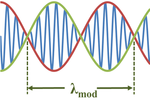Envelope function: Difference between revisions
imported>John R. Brews (→Phase and group velocity: elaborate on different velocities) |
imported>John R. Brews (directions) |
||
| Line 50: | Line 50: | ||
Here ω is the frequency in radians/s. In a medium such as [[classical vacuum]] the dispersion relation for electromagnetic waves is: | Here ω is the frequency in radians/s. In a medium such as [[classical vacuum]] the dispersion relation for electromagnetic waves is: | ||
:<math>\omega = c_0 k </math> | :<math>\omega = c_0 k </math> | ||
where ''c''<sub>0</sub> is the [[speed of light]] in classical vacuum. For this case, the phase and group velocities both are ''c''<sub>0</sub>. In so-called ''dispersive media'' the dispersion relation can be a complicated function of wavevector, and the phase and group velocities are not the same. | where ''c''<sub>0</sub> is the [[speed of light]] in classical vacuum. For this case, the phase and group velocities both are ''c''<sub>0</sub>. In so-called ''dispersive media'' the dispersion relation can be a complicated function of wavevector, and the phase and group velocities are not the same. In more than one dimension, the phase and group velocities may have different directions.<ref name=Cerveny/> | ||
==References== | ==References== | ||
{{reflist|refs= | {{reflist|refs= | ||
<ref name=Cerveny> | |||
{{cite book |author=V. Cerveny, Vlastislav Červený |title=Seismic Ray Theory |url=http://books.google.com/books?id=Moj_V-8U0tEC&pg=PA35 |pages=p. 35 |chapter=§2.2.9 Relation between the phase and group velocity vectors |isbn=0521018226 |year=2005 |publisher=Cambridge University Press}} | |||
</ref> | |||
<ref name=Eberly> | <ref name=Eberly> | ||
Revision as of 13:17, 8 April 2012
- See also: Modulation
In physics and engineering, the envelope function of a rapidly varying signal is a smooth curve outlining its extremes in amplitude.[1] The figure illustrates a sine wave varying between an upper and a lower envelope. The envelope function may be a function of time, or of space, or indeed of any variable.
Example: Beat frequency
- See also: Beat (acoustics)
A common situation resulting in an envelope function in both space x and time t is the superposition of two waves of almost the same wavelength and frequency:[2]
which uses the trigonometric formula for the addition of two sine waves, and the approximation Δλ<<λ:
Here the modulation wavelength λmod is given by:[2][3]
The modulation wavelength is double that of the envelope itself because each half-wavelength of the modulating cosine wave governs both positive and negative values of the modulated sine wave.
If this wave is a sound wave, the ear hears the frequency associated with f and the amplitude of this sound varies with the beat frequency Δf.[4]
Phase and group velocity
The argument of the sinusoids above apart from a factor 2π are:
with subscripts c and e referring to the carrier and the envelope. The same values for these functions occur when these arguments increase by unity, whether that increase is a result of an increase in distance x or an increase in time t. That is, the same amplitude results for ξc and for ξc + 1, and likewise for ξb. This invariance means that one can trace these waveforms in space to find a position of fixed amplitude propagates in time with a speed that keeps ξ fixed; that is, for the carrier:
which determines for a constant amplitude the distance Δx is related to the time interval Δt by the so-called phase velocity vp
On the other hand, the same considerations show the envelope propagates at the so-called group velocity vg:[5]
A more common expression for the group velocity is obtained by introducing the wavevector k:
We notice that for small changes Δλ, the magnitude of the corresponding small change in wavevector:
so the group velocity can be rewritten as:
In all media, frequency and wavevector are related by a dispersion relation, 2πf ≡ ω = ω(k), and the group velocity can be written:
Here ω is the frequency in radians/s. In a medium such as classical vacuum the dispersion relation for electromagnetic waves is:
where c0 is the speed of light in classical vacuum. For this case, the phase and group velocities both are c0. In so-called dispersive media the dispersion relation can be a complicated function of wavevector, and the phase and group velocities are not the same. In more than one dimension, the phase and group velocities may have different directions.[6]
References
- ↑ C. Richard Johnson, Jr, William A. Sethares, Andrew G. Klein (2011). “Figure C.1: The envelope of a function outlines its extremes in a smooth manner”, Software Receiver Design: Build Your Own Digital Communication System in Five Easy Steps. Cambridge University Press, p. 417. ISBN 0521189446.
- ↑ 2.0 2.1 Blair Kinsman (2002). Wind Waves: Their Generation and Propagation on the Ocean Surface, Reprint of Prentice-Hall 1965. Courier Dover Publications, p. 186. ISBN 0486495116.
- ↑ Mark W. Denny (1993). Air and Water: The Biology and Physics of Life's Media. Princeton University Press, p. 289. ISBN 0691025185.
- ↑ Paul Allen Tipler, Gene Mosca (2008). Physics for Scientists and Engineers, Volume 1, 6th ed. Macmillan, p. 538. ISBN 142920124X.
- ↑ Peter W. Milonni, Joseph H. Eberly (2010). “§8.3 Group velocity”, Laser Physics, 2nd ed. John Wiley & Sons, p. 336. ISBN 0470387718.
- ↑ V. Cerveny, Vlastislav Červený (2005). “§2.2.9 Relation between the phase and group velocity vectors”, Seismic Ray Theory. Cambridge University Press, p. 35. ISBN 0521018226.


![{\displaystyle F(x,\ t)=\sin \left[2\pi \left({\frac {x}{\lambda -\Delta \lambda }}-(f+\Delta f)t\right)\right]}](https://wikimedia.org/api/rest_v1/media/math/render/svg/0467cdce58d41ddf370525c035d69f994c3f10a4)
![{\displaystyle +\sin \left[2\pi \left({\frac {x}{\lambda +\Delta \lambda }}-(f-\Delta f)t\right)\right]}](https://wikimedia.org/api/rest_v1/media/math/render/svg/987cb6c9153bdae25867ffef6107a03ecc677376)
![{\displaystyle \approx 2\cos \left[2\pi \left({\frac {x}{\lambda _{mod}}}-\Delta f\ t\right)\right]\ \sin \left[2\pi \left({\frac {x}{\lambda }}-f\ t\right)\right]\ ,}](https://wikimedia.org/api/rest_v1/media/math/render/svg/fe71e240d4a8f95bb96ca9bfebc22f2be9fffabf)











